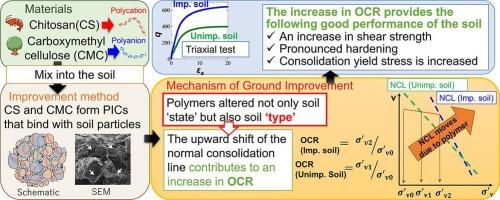Mechanism of ground improvement using biomass-derived polymers based on soil mechanics principles
IF 5.5
2区 工程技术
Q1 ENGINEERING, CIVIL
引用次数: 0
Abstract
Recently, biomass-derived polymers have been increasingly considered as eco-friendly additives and modifiers for various construction materials; however, the mechanical behavior of such systems is poorly understood. This study investigates the effectiveness of soil improvement and its mechanical behaviour using biopolymers, specifically chitosan (CS) and carboxymethyl cellulose (CMC). Laboratory tests were conducted on specimens prepared with varying degrees of compaction ( = 75 % and 90 %), CMC concentrations (0.5 % and 1.0 %), and CS: CMC mixing ratios (1:1 and 2:1). The effects of biopolymer treatment were examined based on soil mechanics principles. In the oedometer tests, specimens with higher CS: CMC ratios exhibited greater consolidation yield stress and compressibility, whereas permeability decreased with the addition of biopolymer. Specifically, at a CS: CMC ratio of 2:1, the consolidation yield stress was approximately 2.5 times higher, and the compression index increased by about 1.3 times compared to unimproved soil. Additionally, the permeability coefficient was reduced to approximately 0.2–0.5 times that of unimproved soil due to the addition of biopolymer. In the triaxial compression tests, a higher CS: CMC ratio led to more pronounced hardening with plastic expansion and improved shear strength. For example, at CMC concentration of 1 % and = 75 %, the maximum deviator stress for CS: CMC = 2:1 was approximately three times greater than that of the unimproved soil. These mechanical behaviours suggest an increase in overconsolidation ratio (OCR). Furthermore, the addition of biopolymers altered not only the soil skeleton structure but also fundamental physical properties such as the liquid limit and compression index, indicating a change in the “type” of soil itself. The upward shift of the normal consolidation line (NCL) caused by biopolymer treatment contributes to an increase in the OCR. These findings provide important insights into the mechanisms of biopolymer-based soil improvement from a geotechnical perspective, enabling the design of more efficient and sustainable soil reinforcement systems.

基于土壤力学原理的生物质聚合物改良土壤的机理
近年来,生物质衍生聚合物越来越多地被认为是各种建筑材料的环保添加剂和改性剂;然而,人们对这类系统的力学行为知之甚少。本研究探讨了生物聚合物,特别是壳聚糖(CS)和羧甲基纤维素(CMC)对土壤改良的有效性及其力学行为。对不同压实度(Dc = 75%和90%)、CMC浓度(0.5%和1.0%)、CS: CMC混合比(1:1和2:1)制备的样品进行了实验室试验。根据土壤力学原理,考察了生物聚合物处理的效果。在粘度计测试中,CS: CMC比较高的试件表现出更大的固结屈服应力和压缩性,而渗透率随着生物聚合物的加入而降低。其中,CS: CMC比为2:1时,固结屈服应力约为未改良土的2.5倍,压缩指数约为未改良土的1.3倍。此外,由于生物聚合物的加入,渗透系数降低到未改良土壤的约0.2-0.5倍。在三轴压缩试验中,CS: CMC比越高,塑性膨胀硬化越明显,抗剪强度提高。例如,在CMC浓度为1%,Dc = 75%时,CS: CMC = 2:1的最大偏差应力约为未改良土壤的3倍。这些力学行为表明超固结比(OCR)增加。此外,生物聚合物的加入不仅改变了土壤骨架结构,还改变了土壤的基本物理性质,如液体极限和压缩指数,这表明土壤本身的“类型”发生了变化。生物聚合物治疗引起的正常固结线(NCL)向上移动有助于OCR的增加。这些发现从岩土工程的角度为生物聚合物土壤改良的机制提供了重要的见解,使设计更有效和可持续的土壤加固系统成为可能。
本文章由计算机程序翻译,如有差异,请以英文原文为准。
求助全文
约1分钟内获得全文
求助全文
来源期刊

Transportation Geotechnics
Social Sciences-Transportation
CiteScore
8.10
自引率
11.30%
发文量
194
审稿时长
51 days
期刊介绍:
Transportation Geotechnics is a journal dedicated to publishing high-quality, theoretical, and applied papers that cover all facets of geotechnics for transportation infrastructure such as roads, highways, railways, underground railways, airfields, and waterways. The journal places a special emphasis on case studies that present original work relevant to the sustainable construction of transportation infrastructure. The scope of topics it addresses includes the geotechnical properties of geomaterials for sustainable and rational design and construction, the behavior of compacted and stabilized geomaterials, the use of geosynthetics and reinforcement in constructed layers and interlayers, ground improvement and slope stability for transportation infrastructures, compaction technology and management, maintenance technology, the impact of climate, embankments for highways and high-speed trains, transition zones, dredging, underwater geotechnics for infrastructure purposes, and the modeling of multi-layered structures and supporting ground under dynamic and repeated loads.
 求助内容:
求助内容: 应助结果提醒方式:
应助结果提醒方式:


